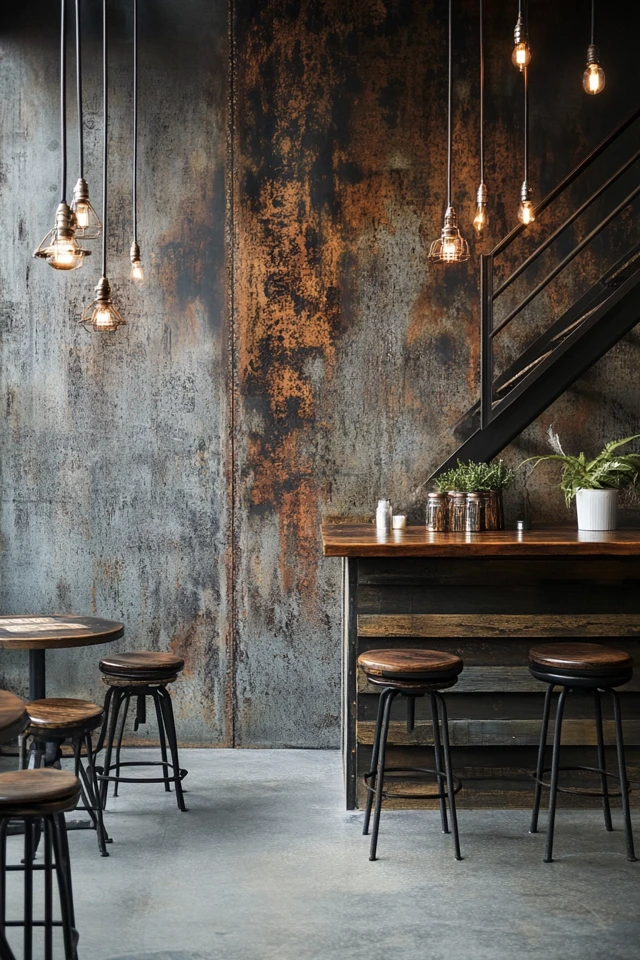Distressed finishes are a cornerstone of industrial décor, evoking a sense of history, character, and authenticity. From weathered wood to chipped paint and rusted metal, these finishes give a raw, lived-in feel that perfectly complements the rugged aesthetic of industrial design. When incorporated thoughtfully, distressed elements can add warmth and texture to spaces dominated by concrete, steel, and brick, creating a balanced and inviting environment.
I’ll never forget the first time I worked on a project that involved sourcing distressed furniture and décor. The client had a love for vintage charm but wanted the space to feel modern and edgy. By using distressed finishes strategically—like a reclaimed wood dining table and a weathered metal bookshelf—we brought a sense of history into a contemporary industrial space. The result was a harmonious blend of old and new, and I’ve been in love with distressed finishes ever since.
In this guide, I’ll share tips and ideas on how to incorporate distressed finishes into your industrial décor, whether you’re starting from scratch or looking to add a touch of vintage charm to your home.
Why Distressed Finishes Work in Industrial Decor
1. Adds Authenticity
Industrial design draws inspiration from factories and warehouses, where materials naturally age and weather over time. Distressed finishes capture this sense of history and authenticity.
2. Provides Texture and Warmth
The rough, imperfect textures of distressed materials soften the stark, cool look of industrial spaces, making them feel more inviting.
3. Celebrates Imperfection
Industrial style embraces the beauty of imperfection, and distressed finishes highlight the natural aging process of materials like wood, metal, and concrete.
1. Start with Distressed Wood
Weathered wood is a versatile material that brings warmth and texture to industrial spaces.
- How to Use:
- Opt for reclaimed wood furniture like dining tables, coffee tables, or shelves.
- Add distressed wood panels as an accent wall or headboard.
- Incorporate vintage crates or wooden storage boxes for functional décor.
- Why It Works: The natural grain and imperfections of distressed wood create a rustic charm that pairs beautifully with industrial elements like metal and concrete.
Pro Tip: Choose lighter finishes for small spaces or darker, richer tones for a more dramatic effect.
2. Incorporate Chipped and Weathered Paint
Chipped paint finishes add a vintage, timeworn feel to your décor.
- How to Use:
- Look for furniture with peeling paint, like cabinets, chairs, or side tables.
- Add picture frames or mirrors with weathered, painted frames.
- DIY your own distressed paint finish using sanding and layering techniques.
- Why It Works: Chipped paint adds visual interest and a touch of nostalgia to industrial spaces.
Pro Tip: Use this finish sparingly to avoid a cluttered or overly shabby look.
3. Choose Rusted Metal Accents
Rusted or patinaed metal is a hallmark of industrial design, lending a rugged, utilitarian edge.
- How to Use:
- Incorporate metal light fixtures, like rusted pendant lights or sconces.
- Opt for furniture with metal frames or legs that show signs of wear.
- Display vintage industrial tools, gears, or machinery as decorative accents.
- Why It Works: The reddish-brown tones of rusted metal add depth and contrast to the often monochromatic palette of industrial décor.
Pro Tip: Protect rusted pieces with a clear sealant to prevent further corrosion and preserve their look.
4. Bring in Distressed Leather
Distressed leather furniture adds a touch of luxury to industrial spaces without feeling too polished.
- How to Use:
- Invest in a vintage or faux-distressed leather sofa or armchair.
- Use leather bar stools or dining chairs with a worn-in finish.
- Add leather ottomans, poufs, or cushions for extra texture.
- Why It Works: The soft, aged look of distressed leather contrasts beautifully with harder materials like metal and wood.
Pro Tip: Stick to neutral tones like brown, tan, or black to stay within the industrial color palette.
5. Highlight Distressed Concrete
Concrete is a staple of industrial design, and distressed or unfinished concrete adds authenticity.
- How to Use:
- Leave floors or walls unfinished to showcase the raw texture of concrete.
- Add a distressed concrete countertop or coffee table.
- Use concrete planters with a weathered finish.
- Why It Works: The natural imperfections of concrete enhance the rugged, utilitarian aesthetic of industrial spaces.
Pro Tip: Soften the look of distressed concrete with warm lighting or textured rugs.
6. Layer Textures with Fabrics
Distressed fabrics like burlap, canvas, or linen can complement harder materials like wood and metal.
- How to Use:
- Add burlap or linen throw pillows to leather sofas or metal chairs.
- Use canvas curtains or fabric wall hangings with a worn, vintage look.
- Incorporate a weathered rug with faded patterns.
- Why It Works: Distressed fabrics add softness and warmth, balancing the rougher textures of industrial materials.
Pro Tip: Stick to neutral colors or muted tones to maintain an industrial vibe.
7. Mix Vintage and Modern Pieces
Combining distressed vintage pieces with sleek modern elements creates a dynamic and balanced industrial look.
- How to Use:
- Pair a distressed wood dining table with modern metal chairs.
- Combine a vintage trunk or coffee table with a contemporary leather sofa.
- Mix vintage light fixtures with modern art or accessories.
- Why It Works: The juxtaposition of old and new keeps your space feeling fresh and layered.
Pro Tip: Limit your distressed pieces to avoid overwhelming the room and maintain a cohesive design.
8. DIY Distressed Finishes
If you can’t find the perfect distressed piece, create your own!
- How to Distress Wood:
- Sand down edges and corners.
- Use a hammer or chains to create small dents and imperfections.
- Apply a stain or paint, then sand again for a weathered look.
- How to Distress Metal:
- Use a patina solution to create a rusted effect.
- Sand down shiny finishes to reveal raw metal underneath.
- How to Distress Fabric:
- Wash fabrics with bleach or sandpaper to create a worn, faded effect.
Pro Tip: Practice on smaller pieces before tackling larger furniture or surfaces.
Picture Gallery
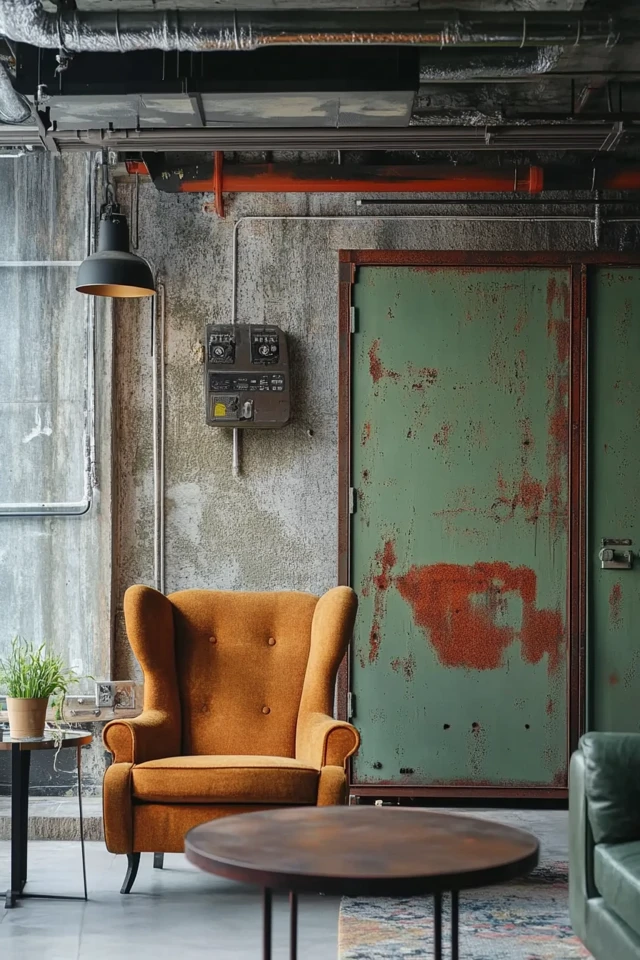
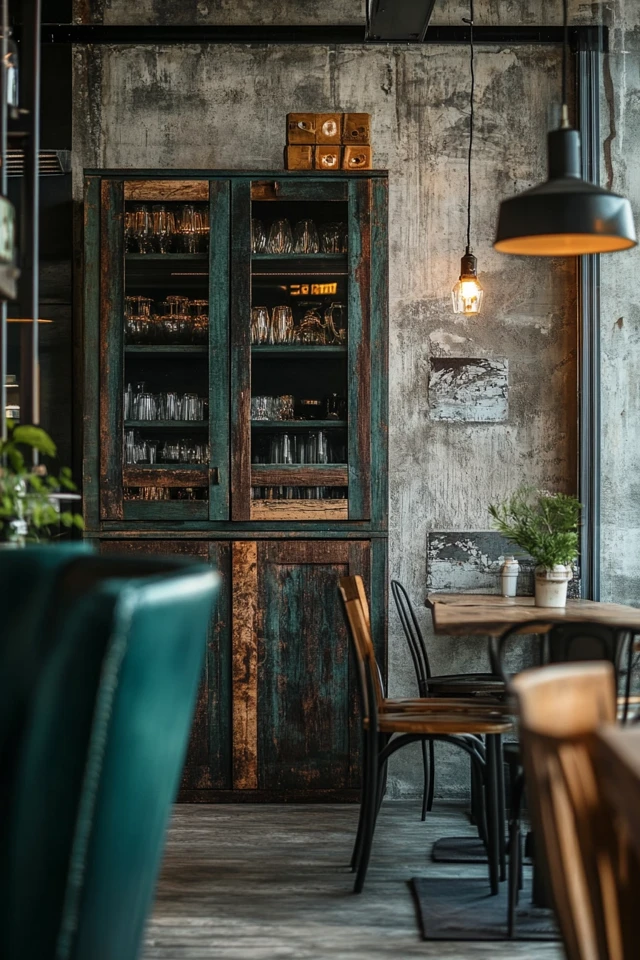
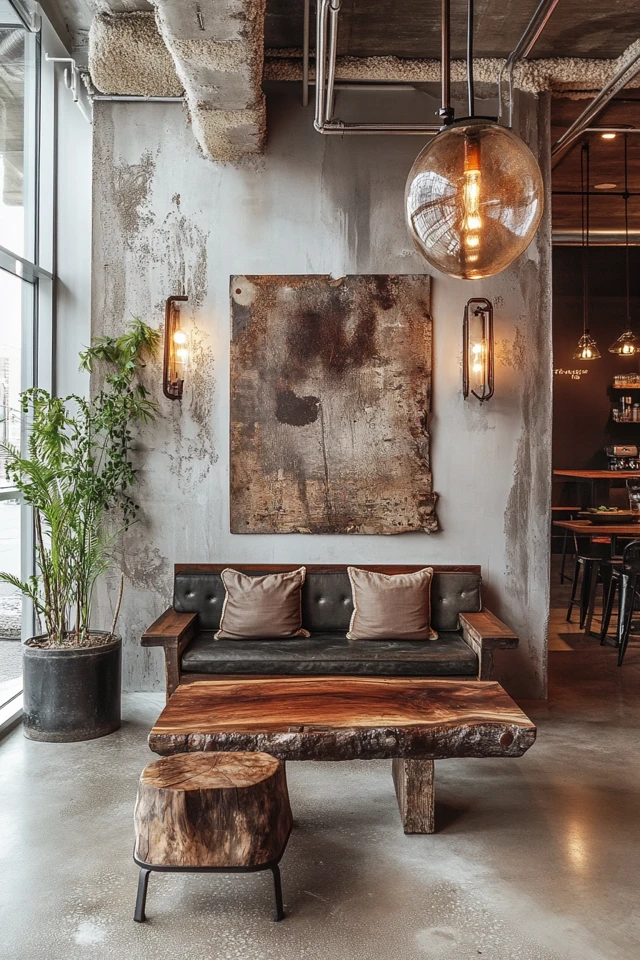
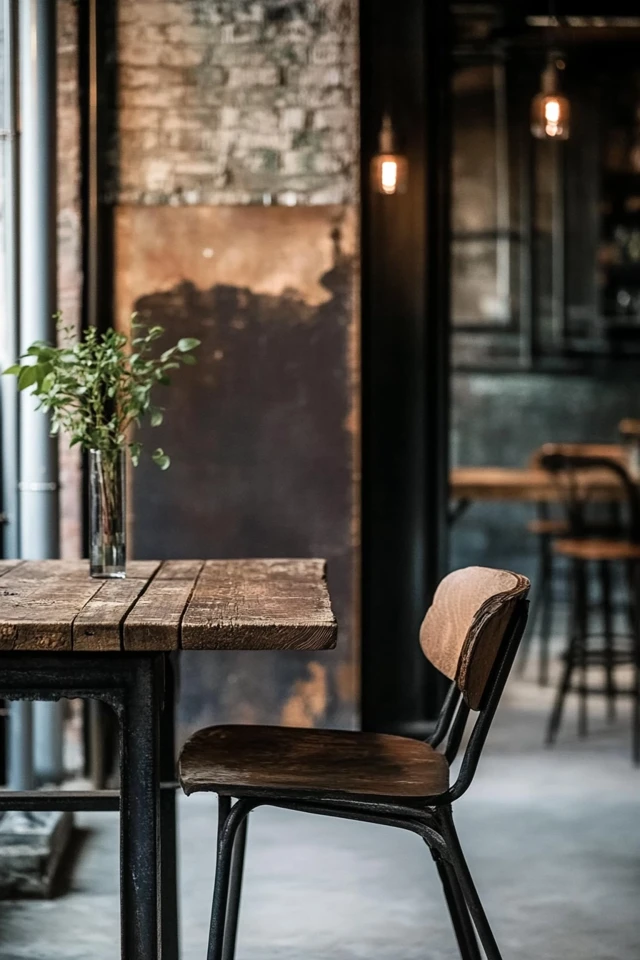

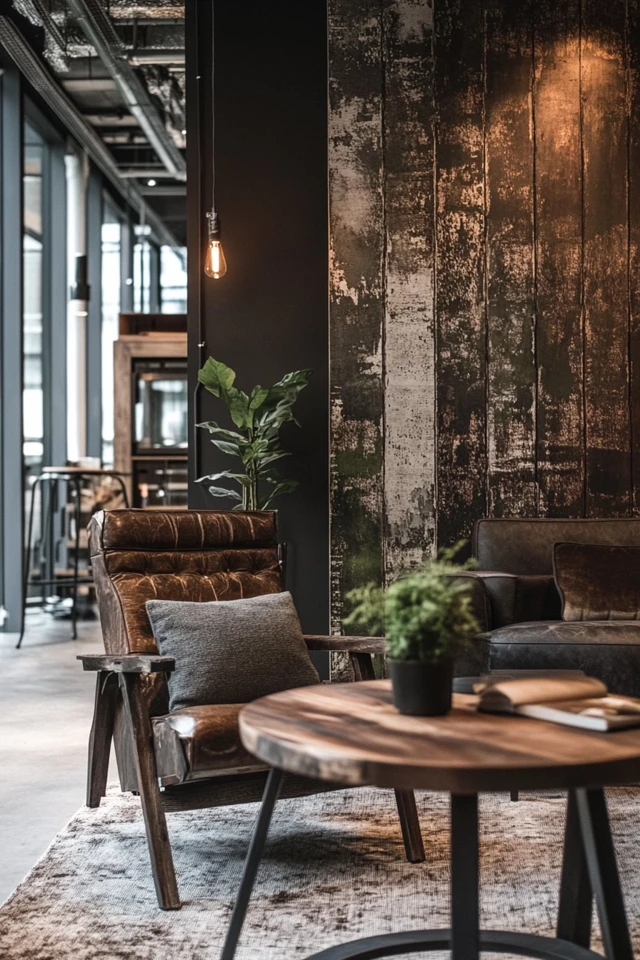
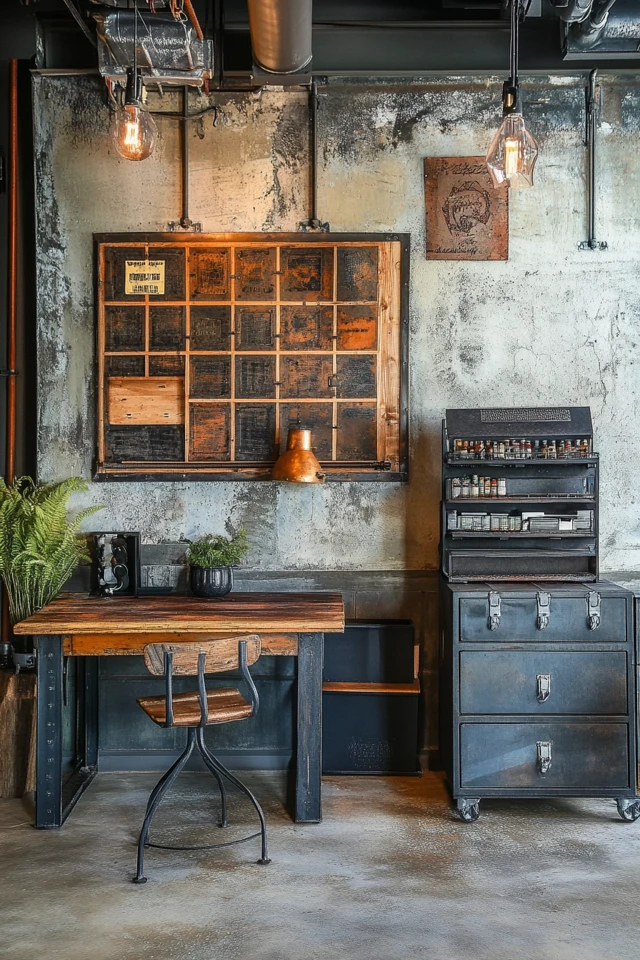
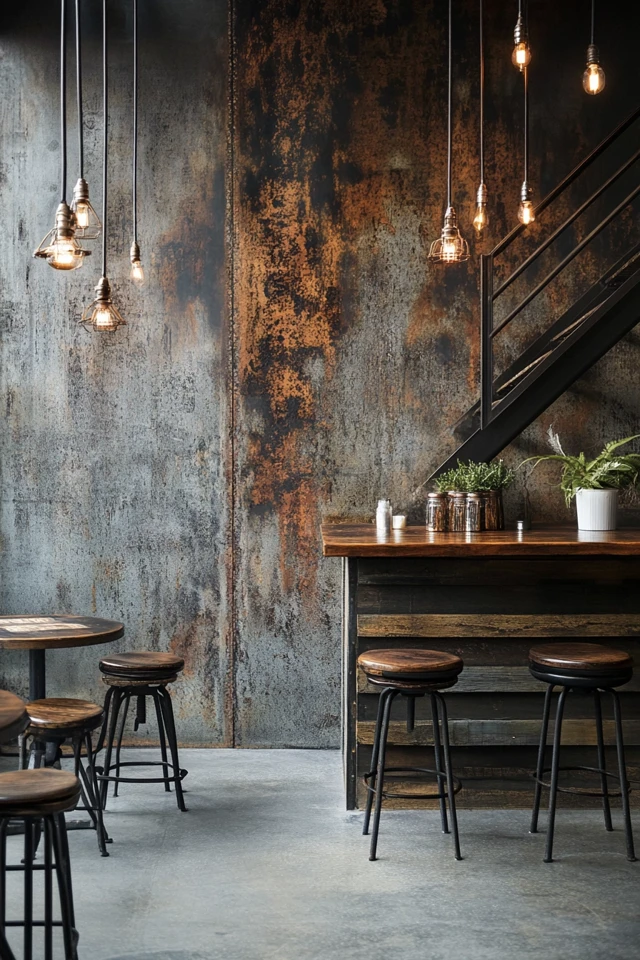
Tips for Balancing Distressed Finishes
- Keep It Minimal: Avoid overcrowding the space with too many distressed elements. Choose one or two key pieces to act as focal points.
- Layer with Polished Finishes: Mix distressed finishes with smoother, more polished surfaces to create contrast and balance.
- Stick to a Cohesive Palette: Use neutral tones and natural materials to keep the overall look harmonious.
- Add Greenery: Soften the ruggedness of distressed finishes with plants in simple, industrial-style planters.
- Focus on Functionality: Ensure your distressed pieces are both beautiful and practical to maintain the industrial design ethos.
Conclusion
Incorporating distressed finishes into industrial décor is all about celebrating imperfection and embracing the beauty of age and wear. Whether you’re working with weathered wood, rusted metal, or aged leather, these finishes add depth, texture, and character to your space.
By pairing distressed elements with raw materials and sleek modern accents, you can create a balanced, cohesive design that feels both rugged and refined. So go ahead—let your space tell a story with the timeless charm of distressed finishes.
FAQs
1. Where can I find distressed furniture and décor?
Check out flea markets, thrift stores, and online marketplaces like Etsy or Facebook Marketplace. Many retailers also offer faux-distressed pieces.
2. Can I DIY distressed finishes?
Yes! Sanding, staining, and using patina solutions are common techniques for creating your own distressed furniture or accents.
3. How do I prevent a distressed space from feeling too cluttered?
Stick to a neutral palette and limit the number of distressed pieces in the room. Balance with modern, streamlined elements.
4. Are distressed finishes durable?
Distressed finishes are inherently forgiving, as signs of wear add to their charm. However, use sealants to protect surfaces like wood or metal from further damage.
5. Can I mix distressed finishes with other design styles?
Absolutely! Distressed finishes work well with rustic, farmhouse, or even contemporary styles for a unique, layered look.

